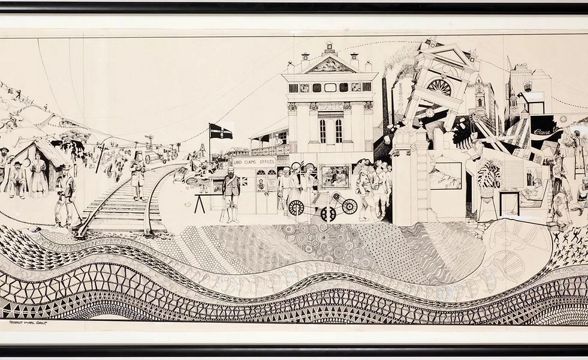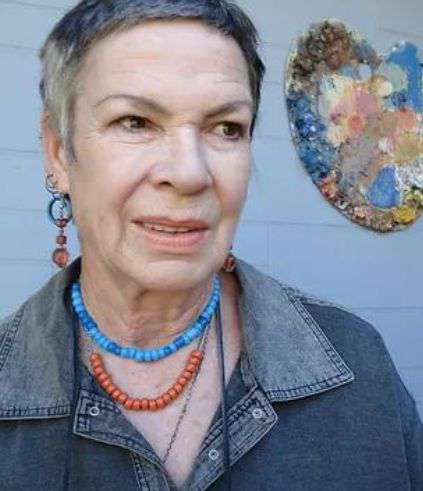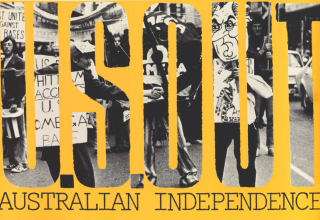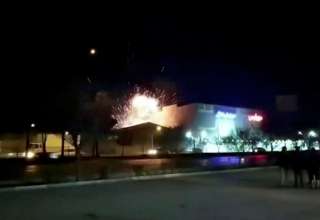by Wallace McKitrick *

Ann Newmarch, accomplished artist, teacher and activist died on 13 January 2022, aged 76. This tribute offers brief biographical notes and recollections of Ann’s powerful role in the movement for an independent and peaceful Australia, especially during the late 1960s to 1980s in South Australia.
Born in 1945, Ann was trained from 1964 to be an artist and educator. Her talent was acknowledged early, and in 1969 she became a lecturer at the South Australian School of Art. Thus began ‘an expansive and internationally celebrated career as a painter, printmaker and sculptor.’ [i]
By the late 1960s, Ann was convinced that Australia’s participation in the US invasion of Vietnam was morally wrong, destructive to the people and land of Vietnam, and damaging to Australian society. She became active in street protests and started to turn her artistic skills to the design and production of anti-war posters. At the same time, she was developing an incisive feminist critique of the institutions of capitalism and the fundamentally unjust day to day power relationships in our workplaces, homes and public life.
Always collegial in her work as both artist and activist, Ann encouraged her students and instilled an exploratory approach. Many a student spoke gratefully of her encouragement and ability to build students’ confidence. In the production of posters and leaflets for public distribution, she shared her excellent skills with co-activists, coaching those who wanted to design posters and helping to organise small teams for lengthy silk-screening sessions to generate enough copies for public distribution.
By the mid-1970s, Ann had gained recognition as an original pioneer in the development of the print medium as an accessible art form. [ii] Through the 1970s and into the 1980s, she remained innovative in this medium to discuss numerous social and political issues, including structural patriarchy, the continuing sovereignty of Aboriginal peoples and Torres Strait Islanders in their ancestral lands, and the menace of US imperialism to Australians’ livelihoods and natural environment.
Julie Robinson, in her essay ‘Ann Newmarch’ [iii], remarks:
‘[Newmarch’s] art practice was based on the philosophy ‘the personal is political’ and by the late 1970s, as a mother of two young boys, women’s issues and motherhood took a greater prominence in her oeuvre. As seen in [the screen-print] Women hold up half the sky! Newmarch aimed to “show the strong encouraging aspects of women”. Initially conceived as an ephemeral poster – “It was never intended as an art image, it was intended as a confirming, joyful, cheap available poster” – its reach has been extensive, being collected and exhibited nationally and internationally. In 2007 it was exhibited in Los Angeles and New York in the ground-breaking WACK! Art and the feminist revolution, a global survey of feminist art. Newmarch, who was represented by nine works, was the only Australian artist included.‘
Women hold up half the sky! (1978) can be viewed at https://knowmyname.nga.gov.au/artists/ann-newmarch/
Ann was an important figure in the founding of South Australia’s Progressive Art Movement and Women’s Art Movement in the mid-1970s. Emphasising collaboration and mutual learning, these forums were dynamic and exploratory, fusing political analysis and artistic strengths in a range of mediums.
The Women’s Art Movement began in Adelaide in 1974 as part of a national network of that name aiming to promote women artists, assert women’s rights in all domains of life and cultivate solidarity. The Movement ‘resulted in a surge of creative action and artwork.’ [iv] In 1977, the Adelaide group hosted The Women’s Show for the whole of August. ‘The national project was organised by a collective of more than 50 women, with sub-collectives organising women-oriented elements for theatre, music, film, photography, poetry and literature, media, a conference and a visual art exhibition. Another collective arranged childminding. The exhibition consisted of work by women artists without any culling of entries for a total of over 350 works.’ [v] One of Ann Newmarch’s contributions was Three months of interrupted work, depicting the struggle to maintain simultaneously the roles of mother, domestic labourer, and artist. In the same year, she completed her series Babies Alive, concerned with uranium mining and the dangers of nuclear power, and Jake and Bruno, 5 years and 5 days, documenting and validating motherhood.

Coinciding with the 1980 Adelaide Festival of Arts, Women’s Art Movement members including Ann painted a huge Reclaim the Night mural on a prominent inner-city wall, asserting women’s right to be safe and to occupy public and private spaces on their own terms. The mural served as a rallying point for Reclaim the Night marches for years thereafter. From the late 1960s onward, feminist theory and practice – especially when derived from working-class experience – transformed previously male dominated political organisations.
The Progressive Art Movement in the same era gave rise to a ferment of shared ideas and joint and individual works analysing foreign control of Australia and the prerequisites of a culture which genuinely springs from this land’s biosphere and societies. The forum was an alliance of people of various occupations, with political perspectives ranging from liberal- and social-democrat to socialist. They saw that Australia was enmeshed in the US machine of international exploitation, coups against elected governments (remember that the Whitlam government was unseated in 1975), and perpetual regional wars. United in the wish to free their country from imperialism of any stripe, the Movement’s members applied their creativity to producing songs, short stories, poems, paintings, screen-prints and other artworks which depicted the problems and proposed solutions. Two-way connections with rank-and-file workers’ groups in several industries, especially vehicle manufacturing and allied businesses, were an essential ingredient.
Ann’s work in this forum included posters, leaflets and screen-printed t-shirts with such themes as nationalisation of the car manufacturing industry, Australian control of vital mineral resources, and related measures to repel predators who suck out mighty profits while impoverishing workers and family farmers.
These were stimulating times. Energy ran high. Over the prior decade, colonial myths and jingoistic false patriotism had been dislodged by Indigenous activism, working-class feminism and the peace movement. In South Australia, the transformational influence of the Women’s Art Movement and Progressive Art Movement was considerable. They laid the foundation for a community-based arts practice working for genuine people’s democracy, by contrast with the somewhat gutted concepts of community arts that emerged in search of government funding by the early 1990s. A number of visual artists, film makers, writers and musicians who were in the groups later earned regional or national reputations. Current movements such as The Spirit of Eureka and the Independent and Peaceful Australia Network (IPAN) have inherited and developed lessons from several such movements around Australia in those years.

From late 1978, Ann’s screen-printing workshops in her Prospect warehouse-studio attracted many community members and artists of all ages keen to learn new skills. In the same year, Ann co-founded the Prospect Mural Group which went on to paint numerous murals in the local area and to coach aspiring muralists from other regions. A notable work by the Mural Group was the large History of Australia, which provided an anti-colonial critique of the ‘official’ white story of settlement and progress. Painting of stobie poles also became a trademark of the group. Today the practice is commonplace in many cities and towns of South Australia.
During the 1980s, Ann’s work continued to discuss crucial Australian problems, such as the massive injury to Western Desert people and their lands caused by atomic testing and uranium mining (for example, in her 1988 painting Maralinga: poisoned rations) and other consequences of the continuing theft of land and blind pursuit of profit (200 years: Willy Willy, 1988).
Of her late 1980s series of paintings, As the Serpent Struggles, Ann said that using symbols such as car, snake and tyre-tread scar, she was attempting to talk about the inroads of white technology into the Australian landscape, cutting across Aboriginal culture and legends. [vi]
In 1997 the Art Gallery of South Australia mounted a large solo exhibition of Ann’s work titled ‘The Personal is Political’ curated by Julie Robinson. Sometimes polemical, sometimes ruminative, it featured an impressive range of visual art mediums and styles. The accompanying publication included this from Ann:
‘Art should be made out of personal experience not out of “art” concerns. Personal experience is only a useful source of art when it is accompanied by an understanding of the social conditions in which it arises. An artist has a responsibility as an image maker to concerns wider than herself or her art.’ [vii]
Despite recurrent ill-health during the last third of her life, Ann continued to produce meaningful work. Now her art is represented in all state galleries and in major private collections, including more than 40 works held by the Art Gallery of South Australia.
It is a fitting tribute to Ann that in 2019 municipal Prospect Gallery – itself an exemplar of commitment to cultural work anchored in the lives of local people – was renamed Newmarch Gallery. Words from the gallery’s website are well worth quoting here:
‘The vibrancy and creativity that now adorns our Council area, from stobie poles and murals, to the Prospect Gallery itself, is a testament to the guidance, perseverance and strong determination that Ann and the broader community showed in the 1980s in raising the profile of arts in the community and creating a strong grass roots movement. Beyond this, she was the first person to have an Artist in Residency with City of Prospect, the first woman to have a retrospective exhibition by the Art Gallery of SA, and is now a widely celebrated artist.’ [viii]
Though the shape of many industries is now different and the microchip has given corporate capitalism new tools for controlling labour and privatising socially-produced wealth, the late 1960s-1980s lessons for cultural workers stand firm. For example: Know your society – research, listen, learn; Ask ‘Who benefits?’ – analyse fearlessly; be clear about your core, heartfelt principles and stand up for them; explore artistically with these purposes in mind; and contribute to solidarity with all compatible networks.
Ann demonstrated these qualities. Her courage and leadership will continue to inspire the movement for a de-colonised Australia characterised by robust community debate and analysis, equitable power relationships and the flowering of culturally diverse arts.
Testimonials to Ann Newmarch containing more details of her artistic development and outlook are available at the following sites:
Newmarch Gallery: https://www.newmarchgallery.com.au/about This site also holds links to a series of oral history recordings of Ann talking about her life and work.
Art Gallery of South Australia: https://agsa-prod.s3.amazonaws.com/media/dd/files/MEDIA_RELEASE_Ann_Newmarch_remembered.b85a19f.pdf
Flinders University Museum of Art: https://www.flinders.edu.au/museum-of-art/collections/take-5/ann-newmarch
National Gallery of Australia: https://knowmyname.nga.gov.au/artists/ann-newmarch/
* Wallace McKitrick was a 1970s trade unions arts organiser and member of the Progressive Art Movement
[i] Flinders University Museum of Art. ‘Ann Newmarch’ at https://www.flinders.edu.au/museum-of-art/collections/take-5/ann-newmarch Accessed 5 February 2022
[ii] Art Guide Australiaat https://artguide.com.au/australian-art-has-lost-two-of-its-greats-vale-ann-newmarch-and-hossein-valamanesh/ Accessed 5 February 2022
[iii] Robinson, Julie. 2020. ‘Ann Newmarch’ in N Bullock, K Cole, D Hart & E Pitt (eds), Know My Name, National Gallery of Australia, Canberra, pp 274–275.
[iv] Winikoff, Tamara 2016. ‘Women in Australian Art’ at https://visualarts.net.au/news-opinion/2016/women-australian-art/ Accessed 6 February 2022
[v]Mendelssohn, J, De Lorenzo, C, Inglis, A, & Speck, C. 2018. Australian Art Exhibitions: Opening Our Eyes. Thames & Hudson, Port Melbourne.
[vi] ‘Ann Newmarch’ in website Art Logic at https://www.artlogic.com.au/artist/ann-newmarch?bio=show Accessed 6 February 2022
[vii] Ann Newmarch, in Julie Robinson and Ann Newmarch. 1997. The Personal Is Political. Art Gallery of South Australia, Adelaide, p 27.
[viii] Newmarch Gallery at https://www.newmarchgallery.com.au/about Accessed 6 February 2022






